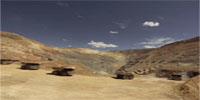
Extension Of Strike Length Of Hercules Silver Deposit
TORONTO – Bald Eagle Gold Corp. reported new zones of high-grade silver, lead and zinc values in soil samples. These discoveries were made during a regional geochemical sampling program at the Hercules Silver Project in the Heath Mining District of Idaho. Subsequent to the acquisition of the Property, the Company acquired the neighbouring Leviathan property and staked additional ground covering a total contiguous land position of 4,256 acres. Following this district-scale land consolidation, the Company conducted a regional geochemical sampling program, which consisted of 1,575 soil samples across the current and expanded land package. The program comprised confirmation sampling over a 640-acre historical survey grid and also over the full 4,256-acre consolidated project area. The new sampling verified strongly anomalous silver values reported by historical operators in the 1970’s and 1980’s. Additionally, it discovered an important extension of the silver-lead-zinc bearing Hercules Rhyolite over 2.6 kilometers southeast of the Belmont Zone. This extends the total strike length to upwards of 5.5 kilometers of favorable high-grade silver host rock, materially increasing the exploration potential of the Property. This newly acquired information, together with the 3D model comprising approximately 300 historical drill holes, will provide the Company with the key information needed to design its future drilling plans.
Chris Paul, CEO and Director, said, “Our new sampling results highlight the scale of silver mineralization at Hercules and demonstrate the potential for high grade mineralization far beyond the limits of historical drilling. These are very high soil geochemical values. 1,063 of 3,397 historical and 2021 soil samples grade 5.0 ppm or higher across the 4,256-acre consolidated project area. Continuous zones of strong silver grades in historical drilling at the Hercules Adit and Fishpond Zones are associated with soil anomalies of up to 1 ounce per ton silver (35 ppm), while several multi ounce silver in soil anomalies remain to be tested elsewhere on the Property. South of the Belmont Zone, a cluster of soil samples on the order of several hundred ppm remains to be adequately drill-tested. A 600 meter long coincident IP geophysical and soil anomaly between Hercules Ridge and Grade Creek currently represents the largest untested soil anomaly on the Property, with values consistently exceeding 1 ounce per ton silver (35 ppm). Finally, the new high-grade soil discovery 2.6 kilometers southeast of Belmont brings the total target strike length on the Property to 5.5 kilometers and demonstrates the significant scale of silver mineralization at Hercules.”
The program’s interim results are now contemplating a mine plan sequence that divides mining of Phase W into four parts. The first two parts would be mined over the next three to four years as part of the open pit, given stripping had already commenced in these areas, and would account for approximately 20% of Round Mountain’s mineral reserve estimates. Phase S mining is expected to start later this year. Mining for the third and fourth parts of Phase W is expected to commence post-2024 and could potentially include underground mining as the Company continues to explore opportunities at Phase X.
At Bald Mountain, in Nevada, production was lower quarter-over-quarter and year-over-year mainly due to timing of ounces recovered from the heap leach pads in the north area of the mine. Production is expected to increase in the second half of the year due to higher heap leach recoveries. Cost of sales per ounce sold was higher compared with the previous quarter and year primarily due to lower production and higher contractor and fuel costs. With approximately 3.6 million gold ounces of estimated measured and indicated gold resources and a pipeline of high-quality targets, the Company is exploring further opportunities for additional resource conversions and exploration success.”
Rollinson continued, “During the quarter, we announced the sale of our Russian assets, and the sale of our Chirano mine in Ghana. With these pending divestments, and the close of the acquisition of Great Bear Resources, our overall portfolio has been re-balanced, with approximately 70% of our production now expected to be generated by our mines in the Americas.
“We have maintained our guidance for our pro-forma portfolio, with a substantial production outlook of 2.15 million gold ounces in 2022, which is expected to grow to 2.3 million gold ounces in 2023. Going forward, we will prioritize balance sheet strength while also returning capital to our shareholders through dividends and our share buyback program.
“We are excited about the future for Kinross which includes a production profile that averages two million ounces a year to the end of the decade, anchored by two tier one assets – Paracatu, in Brazil, and Tasiast, in West Africa – accounting for more than half of our production, and a world-class development project in Canada.
“Over the quarter, we achieved record production at Tasiast, and our project pipeline continued to advance well. The Tasiast 24k project remains on track, and we poured first gold at the La Coipa project, in Chile. We are already making good progress on our exploration program at the Great Bear project, in Candada, and are seeing positive results to support our goal of declaring an initial inferred resource estimate with our 2022 year-end results and our vision of developing a large, long-life mining complex.
“In the important area of ESG, mining responsibly will remain at the core of our business. We were pleased to release our 2021 Sustainability Report, which detailed another year of strong performance. We continued to deliver on our responsible mining goals, ranked well among our peers in major ESG ratings, and provided significant economic benefits to the host countries and communities in which we do business. We are committed to continuously improving our ESG performance, as indicated by our commitment to reduce greenhouse gas emission intensity by 30% by 2030.”
Tasiast performed well and achieved record production during the quarter. The increase in production was mainly due to higher grades, with higher mill throughput contributing to the production increase versus the previous quarter. Cost of sales per ounce sold increased quarter-over-quarter and year-over-year mainly as a result of higher operating waste mined, with higher contractor and maintenance costs also contributing to the increase versus Q1 2021. Tasiast expects to increase production over the year as it mines higher grades and increases throughput.
Production decreased at Paracatu, quarter-over-quarter and year-over-year primarily due to lower throughput and lower grades as a result of planned mine sequencing and temporary mill downtime. Cost of sales per ounce sold was higher compared with the previous quarter and year mainly due to lower production. Higher operating waste mined, maintenance costs and inflationary pressures also contributed to the higher costs versus Q1 2021. Production and costs are expected to improve at Paracatu throughout the year, as mining is expected to move to higher grade areas of the orebody.
At Fort Knox, In Alaska, production was lower compared with the previous quarter mainly due to lower grades, mill throughput and ounces recovered from the heap leach pads, and was largely in line with Q1 2021. Production is expected to increase in the second half of the year as ounces recovered from the heap leach pads typically improve due to seasonality. Cost of sales per ounce sold was higher quarter-over-quarter mainly due to lower production, and increased year-over-year mainly due to higher operating waste mined and increased costs related to contractors, reagents, power, and fuel.
The first gold bar was poured in February 2022 at La Coipa, and the mine produced 524 Au eq. oz. during the quarter. The project was delivered on schedule and under budget despite the challenging global environment over the past two years. The plant is expected to ramp up over the next few months to reach full operating capacity mid-year. The Company continues to study opportunities to further extend mine life by incorporating adjacent pits into the mine plan.
At Chirano, production was largely in line quarter-over-quarter and decreased year-over-year mainly due to lower grades from underground mining. Cost of sales per ounce sold was lower compared with the previous quarter due to higher gold sales, and was higher year-over-year mainly due to lower production.
The process plant at the Tasiast 24k project is now regularly reaching throughput of 21,000 tonnes per day (t/d), with efforts underway to further reduce commissioning downtime. The second phase of the project continues to progress well and is on track to meet throughput of 24,000 t/d by mid-2023. Engineering is planned to be substantially completed during Q2 2022 and construction of the site’s third leach tank is now 70% complete.
The Company provided an update on development at the Great Bear project in Red Lake, Ontario, with assay results from 60 holes drilled in the LP Fault zone continuing to confirm gold mineralization, which is open along strike and at depth. Kinross has received additional assay results from 25 holes since the last update which continue to support the Company’s view of a high-grade, top tier deposit that underpins the prospect of developing a large, long-life mining complex. Kinross remains on track to declare an initial inferred mineral resource for the Great Bear project as part of its 2022 year-end results and commence a pre-feasibility study in 2023.
Exploration, study, and permitting activities continue to ramp up at the project, with approximately 200,000 metres of exploration and infill drilling expected to be completed in 2022. The drilling program will continue to focus on the LP Fault zone, the most significant discovery to date at the project. There are currently eight diamond drills and two reverse-circulation (RC) rigs active on site. The RC rigs are being utilized for a grade control program that is expected to inform the continuity and distribution of the high grade in the LP zone, while also testing grade control methodology. Since March 2022, approximately 11,800 metres of the planned 35,000-metre grade control program have been drilled.
Kinross is also analyzing an advanced exploration program that would establish an underground decline and workings. The advanced program would allow for underground drilling for more efficient exploration of deeper areas of the LP Fault, along with the nearby Hinge and Limb gold zones, as well as bulk sampling. The Company is targeting a potential start of the advanced program as early as 2024.
Baseline environmental surveys and local community socio-economic studies required for the permitting process are underway, and the Company is now working with a team of experts who have permitted multiple operating mines in Ontario. Kinross is also continuing its local stakeholder engagement program and working to foster strong relationships with local communities and with its partners in the Wabauskang and Lac Seul First Nations, on whose traditional territories the project is located.
At the 70%-owned Manh Choh project in Alaska, feasibility study work is progressing well and is expected to be completed on schedule by the end of 2022. Permit applications are advancing as planned, with the Company now liaising with regulators on comments received regarding key permit applications submitted at the end of last year. Kinross has also signed an extension of the community support agreement with the Native Village of Tetlin and is continuing to prioritize transparent community engagements and generating local economic benefits as it develops the project. Initial production is on schedule to commence in late 2024, subject to permitting.
The Lobo-Marte project in Chile continues to provide optionality for Kinross’ long-term portfolio as a potential large, low-cost mine, following the completion of the project feasibility study in November 2021. The timing and go-forward decision for the project will depend on a range of factors, including the gold price environment and projections, economic returns, permitting, priorities in the Company’s portfolio and other potential opportunities in the region, including mine life extensions at La Coipa. Should further La Coipa mine life extension opportunities be successful, Lobo-Marte’s timing is expected to be affected accordingly.
On a pro-forma portfolio basis, Kinross maintained its 2022 production guidance of 2.15 million Au eq. oz. (+/- 5%). The Company continues to expect higher production in the second half of the year, which is largely driven by increased production at Paracatu, Tasiast and La Coipa.
The Company’s 2023 and 2024 production guidance have been adjusted to 2.3 and 2.1 million Au eq. oz. (+/- 5%), respectively. Kinross expects to maintain a substantial production profile with estimated average production of two million Au eq. oz. per year over the remainder of the decade.






